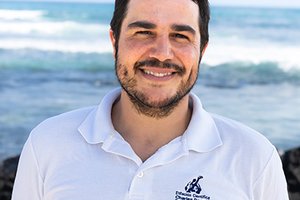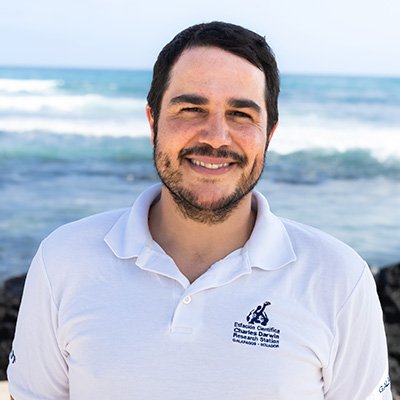
Elasmobranchs (sharks, rays and chimaeras) are among the most threatened group of species on the planet1. Since the end of World War II, we humans got too good at fishing and have managed to remove 9 of 10 sharks and other large predatory fishes from the global oceans2. Only few isolated and/or well protected places still maintain healthy shark populations, and the Galapagos Islands rank as the sharkiest place in the galaxy3.
Because sharks have been totally protected from fishing by the Galapagos Marine Reserve for over 15 years, healthy populations thrive around this volcanic archipelago. Shark-diving tourism generates millions of dollars for the local economy. It is estimated that each live shark in Galapagos is worth U.S. $360.000 annually 4.
Most visitors believe that tohave a shark encounter you need to embark ona multi-day live-aboard mission around the archipelago.However, what most people ignore, even many local residents, is that right on the doorstep of Puerto Ayora, the largest town in the archipelago, anyone can have a close shark encounter.
Blacktip sharks (Carcharhinus limbatus) are coastal sharks commonly encountered around the archipelago. During the first months of the year, and after a 11-12 month gestation period, females give birth to 4-6 half-meter-long pups. Freshly arrived to a hostile world where larger sharks (even members of the same species!) or Galapagos sea lions are trying to have them for lunch, baby blacktips quickly learn to seek shelter. And what better place to hide that an intricate system of roots in shallow water with plenty of baby shark food available?

The Galapagos is also one of the few places on the planet where mangroves, coastal plants that have evolved to tolerate salt water, grow directly on lava. Galapagos mangroves are productive oases of life on an otherwise barren lava desert. Mangroves’ root system, evolved through time to capture sediment and maximize oxygen intake, creates an intricate habitat that serves as substrate for rich invertebrate communities to thrive, and as an essential kindergarten for baby fish. Baby blacktip sharks spend their first year of life in this sheltered environment, a perfect practice ground for their hunting skills, something key for their adult lives as fearsome top reef predators.

And right on the doorstep of Puerto Ayora, in Academy Bay, hundreds of baby blacktip sharks patrol this large mangrove foreston a daily basis, providing an excellent opportunity for a close encounter while snorkeling in less than a meter of water.
”Interacting with sharks is the best therapy to confront any unfounded fear towards sharks. These gentle creatures are not only essential for ecosystems, but they also bring millions of dollars to the local economy,” says Daniela Vilema, Charles Darwin Foundation VP of Education and Outreach.
If you are afraid to get your feet wet, in the evenings the lights of Puerto Ayora’s passengers’ wharf lures baitfish that in turn attract dozens of baby blacktips, creating a unique experience. Where else on the planet can you witness a miniature feeding frenzy while enjoying an artisanal ice-cream?

References
1. Dulvy, N. K. et al. Extinction risk and conservation of the world’s sharks and rays. Elife 3, e00590 (2014).
2. Myers, R. A. & Worm, B. Rapid worldwide depletion of predatory fish communities. Nature 423, 280–283 (2003).
3. Salinas-de-León, P. et al. Largest global shark biomass found in the northern Galapagos Islands of Darwin and Wolf. PeerJ (2016).
4. Lynham, J., Costello, C., Gaines, S. D. & Sala, E. Economic valuation of marine and shark-based tourisms in the Galápagos Islands. 46 (National Geographic Pristine Seas, 2015).






